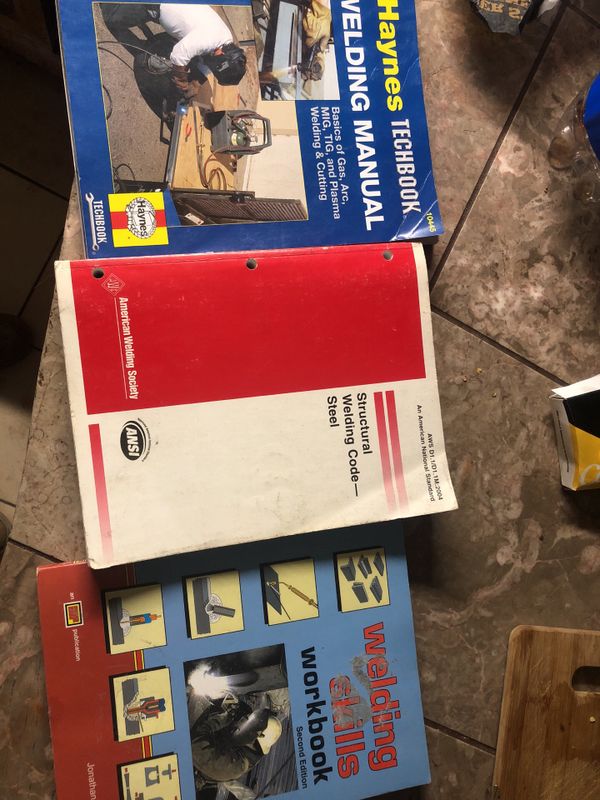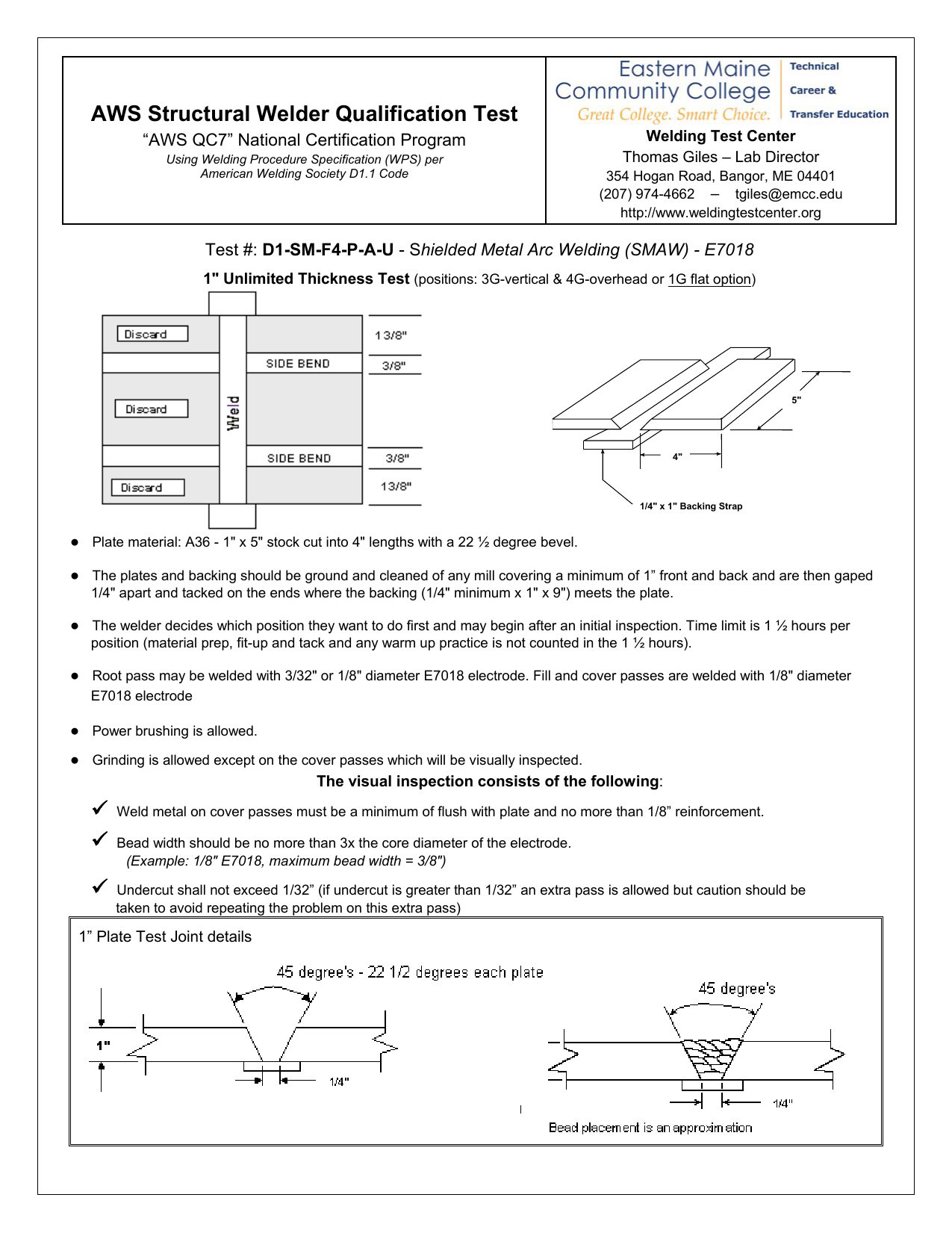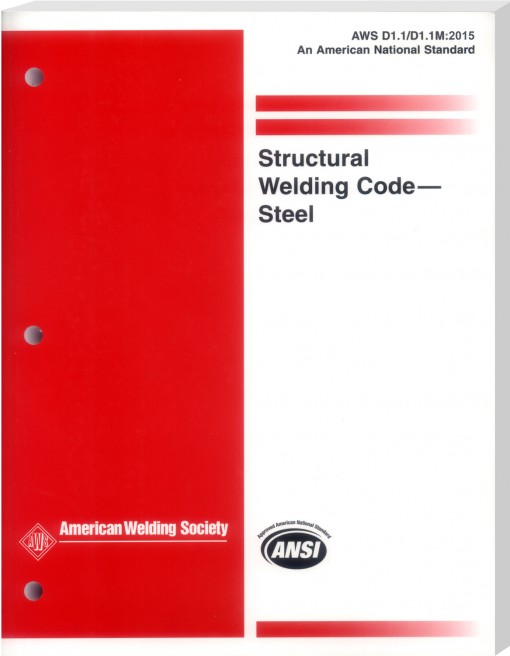Filler Metals for Gas Shielded Arc Welding (9) AWS A5.29:1998, Specification for Low Alloy Steel Electrodes for Flux Cored Arc Welding (10) AWS D1.1:2004, Structural Welding Code— Steel (11) AWS D12.1-75, Reinforcing Steel Welding Code (obsolete, superseded by D1.4-79) (12) AWS QC1-96, Standard for AWS Certification of Welding Inspectors CSA. The AWS D1.1 Structural Welding Code (Steel) welder qualification plate tests consists of a groove weld with a 45-degree included angle. The plates are prepared to a knife’s edge and a ¼ in 6 mm backing strip is used. The test for unlimited thickness will use plates that are 1 in 25 mm thick.
- Aws D1.1 Structural Welding Code Interpretation
- Aws D1.1 Structural Welding Code Free Pdf
- Aws D1.1 Structural Welding Code 2015 Free
- Aws D1.1 Structural Welding Code Table 6.1
- Aws D1.1 Structural Welding Code Book For Sale
- The most widely used welding code in North America, and perhaps the world, is AWS D1.1/D1.1M Structural Welding Code – Steel. It is specified as the quality standard in hundreds of contract documents every year. Yet, we find that less than half of the fabricators that need to use it have a sound understanding of.
- The AWS D1.1 Online Code Clinic provides a detailed road map through AWS D1.1 Structural Welding Code – Steel. Led by an experienced AWS instructor, participants will learn to quickly locate salient clauses and use important tables and figures in time-sensitive testing or working environments.
The AWS D1.1 Structural Welding Code (Steel) welder qualification plate tests consists of a groove weld with a 45-degree included angle. The plates are prepared to a knife’s edge and a ¼ in [6 mm] backing strip is used. The test for unlimited thickness will use plates that are 1 in [25 mm] thick. Anything less than that will qualify the welder for two times the thickness used in the test. Below is an example of a test that will qualify the welder to weld up to ¾ in [20 mm].
Welder performance qualification test for limited thickness.
The backing bar should extend the length of the test plates or could be slightly longer to allow for a run-on and run-off tabs. It should be 1 in [25mm] wide (3 in [75 mm] wide if it will not be removed when radiographic inspection is used for evaluating weld soundness in lieu of bend tests) and ¼ in [6 mm] to 3/8 in [10mm] thick.
Acceptance Criteria
In order for the welder to successfully pass this test, he or she must pass both visual inspection and meet the weld soundness acceptance criteria. Soundness is tested by performing bend tests or by radiographic inspection.

In order to pass visual inspection the weld must:
- Have no cracks of any size
- Craters must be filled to the full cross section of the weld
- The weld must not exceed 1/8 in [3mm] reinforcement
- Undercut must not exceed 1/32 in [1mm] in depth
- Additional requirements apply for tests that have an open root (no backing)
In order to pass weld soundness by bend tests the specimens must:
- Be bent according to the specifications of the code (different bend radii are specified depending on the base metals yield strength).
- The bent specimens should:

- Not exhibit any discontinuities greater than 1/8 in [3mm] in length
- Have no discontinuities greater than 1/32 in [1 mm] in length that combined add up to a total of more than 3/8 in [10mm]. Any single discontinuity exceeding 1/8 in [3 mm] constitutes a failure as seen in “a” above.
- Corner cracks should not exceed ¼ in [6 mm] in length. If the crack is a result of slag inclusion then the maximum length cannot exceed 1/8 in [3 mm]. If a corner crack with no evidence of slag inclusion is present and exceeds ¼ in [6 mm] in length the test specimen is discarded and new specimen cut from the original test plate must be tested. Corner cracks may be the result of poorly prepared tests specimens.
3. As stated previously, radiographic testing may be used in lieu of bend tests. Procedures, technique and acceptance criteria for this type of test is provided in Clause 8 (Inspection) of AWS D1.1/D1.1M:2020 Structural Welding Code – Steel (Clause 6 if you are still using the 2015 edition).
Aws D1.1 Structural Welding Code Interpretation
Welding Positions Qualified
It is sometimes incorrectly assume that the 1G test described above qualifies the welder for all positions. The qualified positions are based on the position used for testing. In this case, the 1G (flat) position for a plate groove weld test will qualify the welder for 1G as well as 1F and 2F (horizontal and flat fillet welds).
For additional information see Table 6.10 of your AWS D1.1 (2020) code book. It provides all the details on welding positions for welder performance qualification. Table 6.11 details the range of thickness qualified.
We administer tests on a regular basis. When working strictly as a CWI we provide no guidance when taking these tests. When we are working as consultants we provide training and provide proper instructions in order to increase the probability of a successful plate test. In next week’s article we will expand on this.
References:
Aws D1.1 Structural Welding Code Free Pdf
The most widely used welding code in North America, and perhaps the world, is AWS D1.1/D1.1M Structural Welding Code – Steel. It is specified as the quality standard in hundreds of contract documents every year. Yet, we find that less than half of the fabricators that need to use it have a sound understanding of how to follow what the code dictates. The number one reason why fabricators turn to AWS D1.1 is to qualify welding procedures and welders. However, this code contains much more than just details on the qualification process. D1.1 can be an invaluable tool that, when applied correctly, can prove to be a tremendous cost savings tool. The purpose of the code is to assure quality, so it reasons that when applied correctly and consistently the quality of the products you manufacture will increase. As quality increases and rework decreases substantial savings can be realized.
This code provides way more detail that you ever thought was available when it comes to making welds on structural components. Yet, it is extremely hard to follow if you have never been given proper instruction on how to do so. It is definitely possible to pick up the code and teach yourself how to use prequalified welding procedures and how to qualify welding procedures by testing. However, with proper instruction you can avoid costly mistakes that are inevitable when you go it alone. Or, at the very least, you’ll be able to speed up the learning curve.
If you ever have a chance to attend a D1.1 code clinic we encourage you to do so. D1.1 can be used as a basis for developing your own quality standards. As stated above, most of us only think of the welding codes only as instructions for qualifying welders and welding procedures and acceptance criteria for the inspection of welds. Welding codes contain much more than that.

Before you can take advantage of the AWS D1.1 you need to understand what it includes. Below we provide a brief description of each of the 9 clauses.
The 9 Clauses of AWS D1.1 CLAUSES

- General Requirements – Provides the scope of the code including material thickness and strength ranges of structural carbon and low alloy steels. Also provides definitions for terms used throughout the code.
- Design of Welded Connections – Spells out requirements for the design of tubular and non-tubular structures for both static and cyclic loading. This clause contains a wealth of engineering information that can help you design weldments properly and avoid costly overwelding. It includes information for designing structures for both static and cyclic loading. Need information on calculating allowable stresses? It’s all in this clause.
Understanding how to calculate the allowable strength for a given weld will allow you to design weldments and provide this information for the shop, rather than expect the shop to make engineering decisions such as the proper size of a weld.
Aws D1.1 Structural Welding Code 2015 Free
- Prequalification of WPSs – Provides the requirements that need to be met in order to be exempt from having to perform testing to qualify welding procedures. The use of prequalified welding procedures has many advantages including saving time and money. If you have subscribed to our weekly articles you know that we developed a step-by-step guide on how to follow Clause 3 of AWS D1.1 in order to simplify the development of prequalified welding procedures. There are a lot of requirements that need to be met. They are spelled out in the code, but can be a bit tricky at times. Become very familiar with this clause. It can save you a lot of money by avoiding unnecessary welding procedure qualification tests.

- Qualification – Provides the requirements to qualify welding procedures, welders, welding operators and tack welders by testing according to code requirements. When prequalified welding procedures cannot be used then the qualification must be done by testing. This clause spells out all the requirements to qualify your procedures. Also, there is no such thing as prequalified welding performance, so all the qualification for welders must be done by testing according to Clause 4. Qualification of Welding Procedures, Welders and Welding Operators has step-by-step instructions on how to qualify procedures and welders.
This guide provides a proven step-by-step process to properly write prequalified welding procedures in conformance with AWS D1.1. Additionally, it provides step-by-step instructions on how to qualify welding procedures and welders by testing.
- Fabrication – Details requirements for base materials, welding consumables and workmanship for the erection of steel structures. If you are welding structural steels you should take this clause and make it your go to when designing products. It contains instructions on many different aspects of fabrication including: storage of consumables, use of fabrication aids, certification of electrodes, ambient temperature restrictions, baking of electrodes, fabricating with weathering steels, preheat and PWHT as well as stress relief heat treatment instructions and many other mandates for proper fabrication of structures.
- Inspection – Describes the requirements for qualification and responsibilities of inspectors. Provides proper procedures for inspecting welds visually as well inspection through other non-destructive methods. Clause 6 contains the acceptance criteria for the visual examination of welds for both statically and cyclically loaded connections. It also provide acceptance criteria for other types of nondestructive testing such as ultrasonic inspection (UT) as well as instructions on how to properly inspect welds with these NDE methods.
- Stud Welding – Describes requirement for welding studs to structural steel. Stud welding is used extensively in the fabrication and erection of steel structure so there are requirements imposed by the code on this welding process.
- Strengthening and Repairing Existing Structures – Provides the requirements for repairing and/or modifying existing structures. When working in accordance to specific welding codes such as D1.1, repairs need to be done according to the instruction approved by the engineer in charge. Repair procedures must be in place and followed. This clause provides information on design for strengthening and repair, fatigue life enhancement, workmanship and technique and quality.
- Tubular Structures – Provides additional requirements specific to tubular (pipe and box) structures. In the current of AWS D1.1 (2015) a significant change was made as compared to the previous edition (2010). Everything related to tubular structures (pipe or box) was separated and placed into its own clause – Clause 9. This simplified qualifications by separating tubular and non-tubular connections.
Clause 9 is basically a stand alone code. It is broken up in 6 parts which mimic the rest of D1.1. The parts in Clause 9 are:
- Design of Tubular Connections
- Prequalification of Welding Procedures
- Qualification of Welding Procedures (by testing)
- Welder Performance Qualification
- Fabrication
- Inspection
Knowing what AWS D1.1 includes can be very useful as it can help you answer many questions that may arise during fabrication and inspection as well as during the qualification of welding procedures and welders. Also, if you are hoping to become a Certified Welding Inspector (CWI) you need to become familiar with codes. You can take part C of the CWI exam on D1.1 or other available codes such as D1.2, D1.5, D15.1, D1.17, API 1104 and ASME Section VIII and IX.
Aws D1.1 Structural Welding Code Table 6.1
To be a CWI you don’t need to be an expert on a specific code or be able to recall requirements off the top of your head. You simply need to know how to find information on the code books. You may test to D1.1, but your CWI certification allows you to perform the duties of a CWI according to any welding code. The CWI exam tests your ability to use a code with which you are not familiar and properly navigate through it and use it for inspection purposes among other things.
Aws D1.1 Structural Welding Code Book For Sale
Reference:AWS D1.1/D1.1M: 2015 Structural Welding Code – Steel